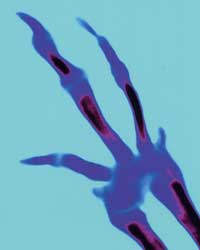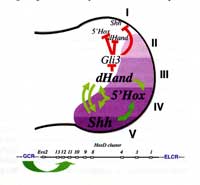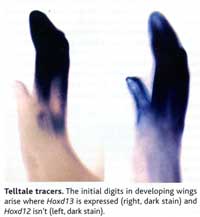
As I laid out in the essay, "Giving Birds the Finger", the Frame-Shift Hypothesis has been proposed as a way to explain why birds and Theropod dinosaurs "appear" to have different digits on their hands.
Some recent work in developmental biology has some bearing on this discussion. I have no expertise in this realm, but I refer you to the original work and provide my best take on what it all means.
(all are pdf files)

Zakany, Kmita and Duboule, Science, 11 June 2004: 1669-1672
This article explains how limb polarity and digit identity are set at a very early stage, when the limb is just an amorphous bud.

Scherz, Harfe, McMahon and Tabin, Science, 16 July 2004: 396-398
This article shows that the digit identity is irrevocably set at this early stage. Any frame shift would have to take place long before the pentadactyl stage shown in the micrograph above.
Pennisi, Science, 14 January 2005: 194-195
This is a review of a paper by Vargus and Fallon published in The Journal of Experimental Zoology which purports to show that frame shift is real and demonstrable.
The embryonic hands portrayed are quite far along. I wonder what the same research would show in the pentadactyl stage. Would there be two digit Is, (DIa and DIb) one of which is programmed to go away while the other continues to develop? Why?

This all still seems pretty ad hoc to me. I can't imagine anyone suggesting such a thing if we hadn't been calling Theropods' fingers I, II and III for a hundred years. Additionally, Alan Feduccia has pointed out that frame shift has never been identified in any amniotes. And when it has occurred in amphibians it has occurred in both front and rear limbs. Remember: front and rear limbs are serially homologous.
This will continue.
